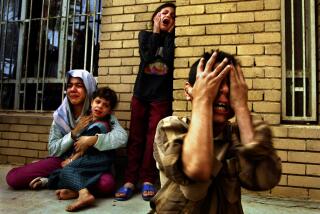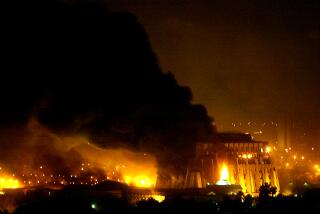Good News From the Front
- Share via
SOUTH POMFRET, Vt. — On April 3, the U.S. Army’s 3rd Infantry Division was poised to move through Iraq’s Karbala Gap toward Baghdad. The fighting was widely expected to be tough. Saddam Hussein’s back was to the wall, and the Republican Guard’s Medina Division barred the way.
The original plan for the 3rd Division, a “heavy” force of Abrams tanks and armored Bradley fighting vehicles, followed the precept of Hans Guderian, legendary German tank commander of World War II: “fist, not fingers.” Armor should deliver a single smashing blow, not be spread out in weaker individual thrusts.
For the record:
12:00 a.m. June 1, 2003 For The Record
Los Angeles Times Sunday June 01, 2003 Home Edition Opinion Part M Page 3 Editorial Pages Desk 1 inches; 40 words Type of Material: Correction
Heinz Guderian -- In an article analyzing tactics in the recent Iraq war (“Good News From the Front,” May 11), a World War II German tank commander was referred to as Hans Guderian. The first name should have been Heinz.
On the eve of the U.S. assault, however, intelligence analysts reported that the Medina Division had been so badly damaged by U.S. air, artillery and rocket attacks that it was “combat-ineffective.” Acting on that assessment, division commanders undertook a daring change in plans: They would abandon the fist and opt for fingers.
As it turned out, April 3 was a pivotal day, with the U.S. Army fighting its last full battle of the Iraq war. The day’s events, and the change in plans, are vividly portrayed in 800 pages of dispatches from journalists embedded with the 3rd Division. The 85 journalists assigned to the division included such media stars as Ted Koppel and the late David Bloom, who died while covering the war, as well as correspondents for major national newspapers. Journalists were also assigned to the division from less prominent news outlets, ranging from the Voice of America to local newspapers in Georgia.
Some have argued that embedding was a masterstroke of Pentagon public relations that destroyed the independence of the news media. But a review of the news stories out of the 3rd Division, collected by a military source, tells a different story.
By the end of the day on April 3, the division’s 20,000 troops were everywhere. The change of plans had paid off. In one day, forward elements advanced almost 40 miles to Saddam International Airport. Ten miles east of the airport, U.S. infantry seized the intersection of Highways 8 and 1, the main roads leading into Baghdad. Twenty-five miles farther east, armored units neared the Medina Division’s onetime headquarters in Suwayrah on the Tigris River.
Each of these finger thrusts was described in news dispatches with an immediacy that matches the best of the reporting from World War II. These firsthand reports will one day be a treasure trove for historians. And they give the lie to the notion that the embeds were censored or that they lost objectivity by getting too close to individual soldiers and units.
That said, embedding alone didn’t make for comprehensive war coverage. No single reporter working at the level of a company or battalion could hope to convey the full scope of a military campaign, much less its political and other ramifications. Providing context and meaning was the responsibility of editors back home.
What is clear, however, is that the embedded journalists did not shy away from reporting things that the U.S. military was doing its best to ignore. Most notably, Iraqi casualties. Fearful of public reaction, senior U.S. officials in the region and in Washington steadfastly refused to discuss how many Iraqi soldiers and others were dying as a result of the coalition’s overwhelming firepower. Not so the embeds.
As the 3rd Infantry moved forward April 3, embedded reporters gave combat a human face -- an Iraqi, as well as an American, face. Although official briefers seemed to suggest enemy resistance had somehow evaporated, reporters on the scene made clear that thousands of Iraqi fighters were killed. By the time U.S. units reached the Euphrates River, William Branigin of the Washington Post reported, “the Medina Division had been effectively annihilated by airstrikes and rocket barrages.”
The road from the Euphrates to Baghdad was lined with hundreds of burning vehicles, civilian and military, Chris Tomlinson of Associated Press wrote. “Hundreds of dead Iraqis, most in uniform, lay next to the vehicles.”
Oliver Poole of the British Daily Telegraph reported that “bodies dressed in the uniform of the Republican Guard and burnt-out vehicles were strewn around the roadways.” A sergeant who had also served in Operation Desert Storm told Poole: “I hope we don’t experience anything like that again ....When I see that many bodies, I just don’t want to be here anymore.”
Michael Corkery of the Providence Journal reported that U.S. officers in the field estimated Iraqi losses at about 500 soldiers from the 14th Brigade of the Medina Division alone.
“We’re told 3rd Infantry has inflicted 4,000 Iraqi deaths by some estimation from several officers that I have talked to today,” CBS reporter Jim Axelrod told viewers. Ron Synovitz of Radio Free Europe/Radio Liberty reported that Maj. Joffery Watson, an intelligence officer with the 2nd Brigade of the 3rd Division, estimated that 3,000 to 4,000 Iraqi troops were killed by combined U.S. air and ground attacks.
“I have seen scores of dead Iraqi soldiers lying on the roadside, more dead bodies than I have seen in my entire 20 years of work as a journalist, both in battlefields and as a police reporter in the inner cities of the United States,” Synovitz reported.
The battlefield is a chaotic place, and reporting from the 3rd reflects that chaos. It is also, by its nature, a view of the trees, not the forest. On April 3, hardly anyone could digest such rapid movement on so many fronts. At the airport and on the southern doorstep of the city, no one quite knew what lay ahead.
“The seizure of the airport raised one pressing question that even commanders here said they could not answer: What comes next?” wrote Steven Lee Myers of the New York Times.
“Hopefully this is a sign that we’re able to send to the residents of Baghdad that we’re here and they can rise up and deal with the regime appropriately and save some future battle inside the city,” Lt. Col. Scott Rutter, commander of the 2nd Battalion 7th Regiment of the 3rd Infantry, told AP.
The Los Angeles Times, in a story by Geoffrey Mohan and Tony Perry, speculated that “control of the airport should give the Pentagon the ability to fly in a brigade-sized force of the Army’s 4th Infantry Division.... There now are about 40,000 U.S. Army and Marine troops on the outskirts of Baghdad -- not enough, in the estimation of many military officials, to mount a well-thought-out and cautious attack on a city of more than 5 million people.”
Embedded reporters were describing an Iraqi opponent that was, although they couldn’t know it, already defeated.
Two days after the 3rd Division’s drive north through the Karbala Gap, it undertook the most audacious move of the war. “Desert Rogue,” the 1st Battalion, 64th Armor, left the crossroads of Highways 8 and 1 at dawn to drive through downtown Baghdad on a mad dash for the airport. “It was three hours of organized chaos,” the battalion commander told the New York Times’ Myers.
All along the 15-mile route, Iraqis fired from rooftops and storefronts, bridges and underpasses. When it was over, U.S. commanders estimated that 1,000 Iraqi fighters had been killed. One U.S. soldier died.
“It’s called ‘Let me poke you in the eye because we can and you can’t do anything about it,’ ” Col. William Grimsley told Agence France-Presse.
Can anyone who reads this record really contend that it is the product of a controlled and manipulated news media?
More to Read
Sign up for Essential California
The most important California stories and recommendations in your inbox every morning.
You may occasionally receive promotional content from the Los Angeles Times.













